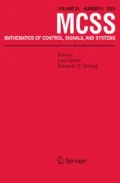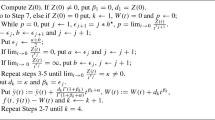Abstract
We investigate here the interpolation conditions connected to an interpolating function \(Q\) obtained as a Linear Fractional Transformation of another function \(S\). In general, the degree of \(Q\) is equal to the number of interpolating conditions plus the degree of \(S\). We show that, if the degree of \(Q\) is strictly less that this quantity, there is a number of complementary interpolating conditions which has to be satisfied by \(S\). This induces a partitioning of the interpolating conditions in two sets. We consider here the case where these two sets are not necessarily disjoint. The reasoning can also be reversed (i.e. from \(S\) to \(Q\)). To derive the above results, a generalized interpolation problem, which relaxes the usual assumptions on disjointness of the interpolation nodes and the poles of the interpolant, is formulated and solved.
Similar content being viewed by others
References
Alpay D (1998) Algorithme de Schur, espaces noyau reproduisant et theorie des systmes. In: Panoramas et Syntheses, vol 6. Société Mathmatique de France, France
Bolotnikov V, Dym H (2006) On boundary interpolation for matrix Schur functions. Mem Am Math Soc 181(856)
Ball JA, Gohberg I, Rodman L (1988) Realization and interpolation of rational matrix functions. Operator Theory Adv Appl 33:1–72
Byrnes CI, Georgiou TT, Lindquist A (2001) A generalized entropy criterion for Nevanlinna–Pick interpolation with degree constraint. IEEE Trans Autom Control AC-46:822–839
Dym H (1989) J-contractive matrix functions, reproducing kernel Hilbert spaces and interpolation. In: CBMS regional conference series in mathematics, vol 71. Amer Math Soc, Providence
Dym H (2001) On Riccati equations and reproducing kernel spaces, in recent advances in operator theory: the Israel Gohberg anniversary volume, Israel Gohberg, Aalt Dijksma MA, Kaashoek and André CM Ran (eds) Operator Theory Adv Appl 124:189–215
Francis B (1987) A course in \(H^{\infty }\) control theory. Springer, New York
Georgiou TT (1987) Realization of power spectra from partial covariance sequences. IEEE Trans Acoust Speech Signal Process AASP-35(4):438–449
Gombani A, Michaletzky Gy (2007) On the Nevanlinna–Pick interpolation problem: analysis of the McMillan degree of the solutions. Linear Algebra Appl 425:486–517
Kimura H (1985) Positive partial realization of covariance sequences. In: Byrnes CI, Lindquist A (eds) Modelling, identification and robust control. North-Holland, Amsterdam, pp 499–513
Kucera V (1980) Discrete linear control: the polynomial equation approach. Wiley, New York
Nevanlinna R (1929) Über beschränkte analytische Funktionen. Ann Acad Sci Fenn 32:1–75
Pick G (1916) Über beschränkte analytische Funktionen, welche durch vorgegebene Funktionswerte bewirkt werden. Matematische Annalen 77:7–23
Schur I (1917) Über die Potenzreihen, die im Innerne des Einheitkreises beschränkt sind. Journal für die reine und angewandte Mathematik 147:205–232
Youla D, Jabr H, Bongiorno J Jr (1976) Modern Wiener–Hopf design of optimal controllers—part II: the multivariable case. IEEE Trans Autom Control AC-21:319–338
Wyman BF, Sain MK (1987) Module theoretic zero structures for system matrices. SIAM J Control Optim 25:86–99
Author information
Authors and Affiliations
Corresponding author
Rights and permissions
About this article
Cite this article
Michaletzky, G., Gombani, A. On the “redundant” null-pairs of functions connected by a general Linear Fractional Transformation. Math. Control Signals Syst. 24, 443–475 (2012). https://doi.org/10.1007/s00498-012-0088-9
Received:
Accepted:
Published:
Issue Date:
DOI: https://doi.org/10.1007/s00498-012-0088-9



